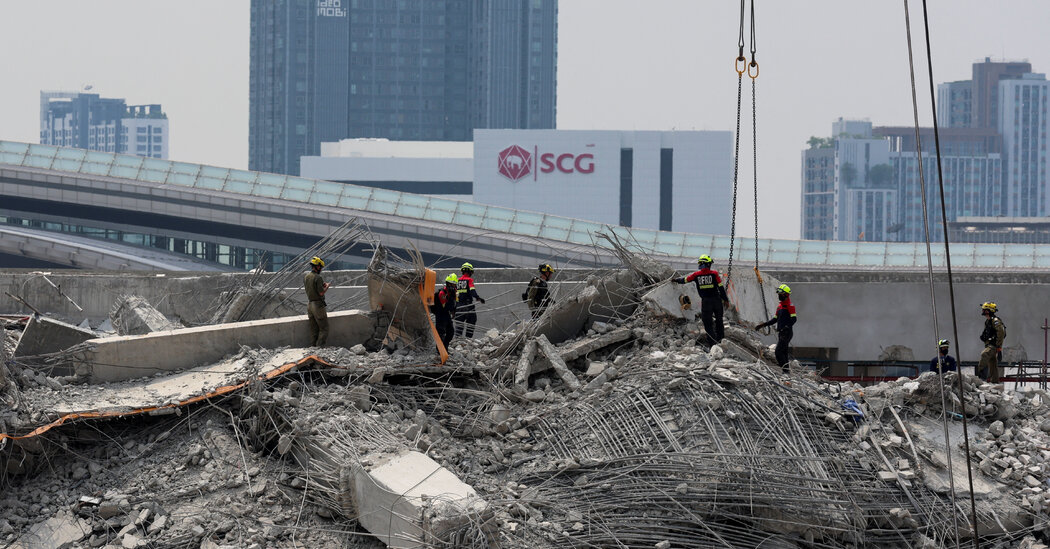
More than 600 miles separated the epicenter of Friday’s earthquake in Myanmar from the skyscrapers of Bangkok, which lurched and swayed on the skyline of the vast metropolis. A 33-story high-rise under construction even collapsed. How could the shaking in Bangkok, the Thai capital, be connected to an earthquake so far away?
The answer involves low frequency seismic waves, which are capable of traveling vast distances and making high-rise buildings sway.
When a large earthquake strikes, it simultaneously radiates different frequencies of shaking. Some produce a rapid back-and-forth rattling, others low-frequency swaying.
That was true on Friday, when the earthquake in Myanmar produced violent, high-frequency seismic waves; they destroyed low-rise buildings, Buddhist pagodas and other structures near to the quake’s epicenter just outside Mandalay, Myanmar’s second largest city. Many of the destroyed places were made with brick and masonry, brittle materials that are susceptible to that kind of shaking.
When released from an earthquake, high frequency seismic waves spread through the interior of the earth, where they dissipate. Low frequency waves, in contrast, travel along the earth’s crust and for greater distances.
During the 7.9 magnitude Denali earthquake in Alaska in 2002, low frequency waves traveled so far that they caused water in swimming pools and ponds to splash as far away as Texas and Louisiana — harmlessly, but for nearly half an hour, according to NASA.
These types of seismic waves also have particular resonance with tall buildings.
Similar to tuning forks, which produce different sounds depending on their size, buildings react differently to earthquakes depending on their design, and especially their height.
A 10-story building might require one second to sway from side to side during an earthquake, while a 50-story building could take five seconds to complete the same motion, a nausea-inducing back and forth.
Low frequency seismic waves were a key factor in an earthquake in in 1985, when close to 900 buildings in Mexico City, the nation’s capital, partially or totally collapsed. The extensive destruction initially puzzled seismologists and engineers because the epicenter of the 8.0-magnitude earthquake had been a relatively long distance away, more than 200 miles to the west of the city.
They concluded that the seismic waves had resonated with particular force through the clay and silt soils of the city, an aggravating factor in the quake and its aftermath.
A similar dynamic was at play last Friday. As the low frequency shaking pulsed across mainland Southeast Asia, it was amplified in and around the Thai capital, because the city is built on the soft soils of the Chao Phraya River delta.
In recent years scientists say they have underestimated the potential of these soft soils to make earthquakes more dangerous. Engineers compare the dynamic to constructing a building on a bowl of Jell-O.
In addition to Bangkok and Mexico City, Los Angeles, downtown San Francisco, Seattle and Tokyo are all cities subject to these so-called basin effects, which can multiply the destructive power of earthquakes, especially at low frequencies.
In Mexico City in 1985, the frequencies of the seismic waves were crucial to understanding the damage caused by the earthquake. A team of American scientists concluded in a report published by the Department of Commerce in 1987 that most of the severe damage “was confined to buildings in the height range of seven to 18 stories.” The reason for this, they said, was a combination of the lower frequency seismic waves reaching the city and construction that was vulnerable at those frequencies.
The report noted that “older, low-rise masonry buildings generally performed well, as did the massive stone masonry colonial churches and government offices.” Paradoxically, those are the types of buildings that engineers consider the most vulnerable to the shaking near the epicenter of earthquakes.
Until the 1950s, many American engineers shunned the construction of high-rise buildings in earthquake-prone areas, according to Thomas H. Heaton, an emeritus professor at the California Institute of Technology who has spent his five-decade career studying the effects of large-magnitude earthquakes on buildings.
The prevailing wisdom, he said, was to build stronger, stiffer buildings. But that changed over the decades, and today’s skyscrapers are more flexible.
Dr. Heaton says the flexible design of modern skyscrapers works well with earthquakes of magnitudes around 6, which occur more frequently. But he is very concerned about the consequences of less frequent, larger quakes, which have highlighted the vulnerability of tall buildings. That roster includes a 7.8 magnitude earthquake that killed more than 50,000 people in Turkey two years ago.
A massive fault rupture beneath a modern city — a direct hit — would be devastating to tall buildings, no matter the engineering precautions, Dr. Heaton says.
The violent movement of the ground at the fault, the slip as seismologists call it, would cause the base of a high rise to shift rapidly, potentially leaving the top floors unsupported, he said.
“When you take the base of a building and move it by several meters in less than a couple of seconds, there’s almost nothing a structural engineer can do to have a building stay upright,” he said. “I definitely wouldn’t want to be in a really tall building during a large magnitude earthquake.”








